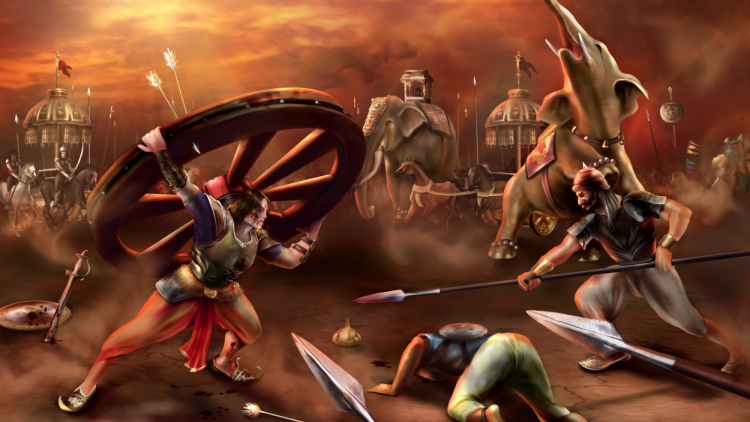The Nonviolent Violence of the Gita
By Chaitanya Charan Das | Nov 27, 2013

The battlefield setting of the Gita often prompts people to ask the question: “How can God instruct a peace-seeking person to fight a deadly war that caused so much suffering?”
The Gita (05.29) unequivocally declares that Krishna is the greatest well-wisher of all living beings. He never wants to cause anyone any suffering; in fact, he wants to end all sufferings of everyone. And his instructions are meant to promote that benevolent purpose.
Let us understand this by looking at a paradoxical instruction of Krishna. In the Gita (11.55), he asks Arjuna to work for him (mat-karma krn) and to never bear malice towards anyone (nirvairah sarva-bhuteshu). For Arjuna to do Krishna’s work meant fighting the war against the Kauravas headed by Duryodhana. How could he fight without malice? In other words, how could he be nonviolently violent?
The fact is that neither Krishna nor Arjuna desired to harm Duryodhana – the war was their last recourse to protect Duryodhana from his selfish lower nature that was harming himself and everyone else, including the Pandavas.
Gita wisdom explains that all of us have a selfless higher nature, our spiritual side, and a selfish lower nature, our material side. Krishna wants us to triumph over our lower nature, as the Gita (03.43) urges, and thereby do good to ourselves as well as everyone else. To help us win our inner war, he shares spiritual knowledge (Gita 04.01). And he also personally descends (04.09) to protect dharma which is essentially the means to apply that spiritual knowledge and thereby win the inner war. An integral part of dharma is to act as the well-wisher of all living beings, as the Gita (12.13) exhorts, and help them win their individual inner wars. Thus, from the enlightened spiritual perspective, everyone is our on our side – everyone is like us, pure souls pitted against their lower natures.
Unfortunately, in this war, the lower nature so seduces some people that they fight for it instead of against it. Such misled people rebuff all counsel intended to help them see how they are ruining themselves by their defection. Duryodhana was a tragic example of such an individual whose greed so dominated and perverted him that he shamelessly perpetrated grievous injustices against the Pandavas. Not only that, he scornfully rejected the counsel affectionate elders like Vidura and Bhishma, venerable sages like Vyasa and Maitreya, and even the Supreme Lord, Krishna, who accepted the menial post of a peace messenger in a last-ditch effort to avoid bloodshed.
In fact, the Mahabharata describes in an entire section, the Udyoga Parva [The Book of Effort], the vigorous efforts of the Pandavas to avoid war. And after the war, the longest section of the Mahabharata entitled Shanti Parva describes elaborate guidelines for the king to rule justly and thereby do everything possible to maintain peace.
But despite the best efforts, some people like Duryodhana are so bent on gratifying their lower nature that only the surgical treatment of capital punishment can redeem their lost souls. For such extreme situations, the Gita does not fight shy of recommending physical warfare. But even while fighting such an unavoidable war, it urges us to not let animosity blind us to spiritual reality, as is demonstrated in the Gita’s call (11.55) to Arjuna to do his prescribed duty of fighting and yet not give in to animosity. The Pandavas honored the Gita’s call for nonviolent violence, as is evident in their arranging after the war for a respectable funeral of the Kauravas for their spiritual welfare.
For most of us, this nonviolent violence doesn’t have to ever express itself as physical violence. Our relationship conflicts hardly ever warrant drastic actions like violence. For resolving such conflicts, Gita wisdom urges us to remember that we are not fighting against people, but are fighting against their lower nature. This insight can deter us from malevolent responses that will involve our succumbing to our lower nature and making a bad situation worse. By remembering that others are like us in that they are also battling their lower nature, we can direct our nonviolent violence against our lower nature. We can choose mature responses that express our higher nature, thereby doing our best to improve the situation. And we may well be surprised how often our choosing to honor our higher nature will inspire others to similarly act according to their higher nature, thereby dramatically improving the prospects of a win-win resolution.
Thus the Gita’s insight that we are all on the same side in the inner war and the Gita’s call for nonviolent violence in this war is the strongest foundation for sustainable peace.















